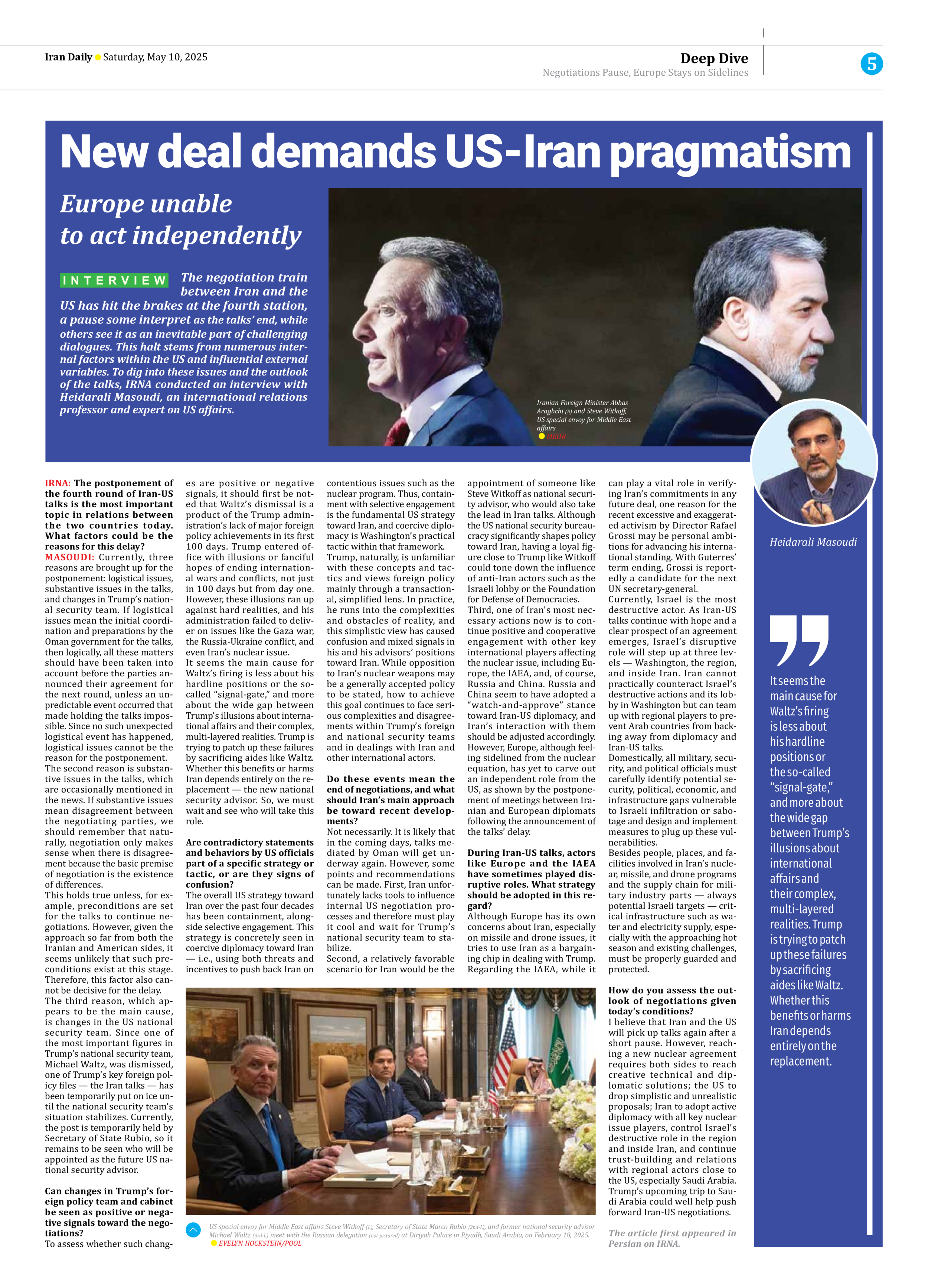
New deal demands US-Iran pragmatism
Europe unable to act independently
The negotiation train between Iran and the US has hit the brakes at the fourth station, a pause some interpret as the talks’ end, while others see it as an inevitable part of challenging dialogues. This halt stems from numerous internal factors within the US and influential external variables. To dig into these issues and the outlook of the talks, IRNA conducted an interview with Heidarali Masoudi, an international relations professor and expert on US affairs.
Heidarali Masoudi
IRNA: The postponement of the fourth round of Iran-US talks is the most important topic in relations between the two countries today. What factors could be the reasons for this delay?
MASOUDI: Currently, three reasons are brought up for the postponement: logistical issues, substantive issues in the talks, and changes in Trump’s national security team. If logistical issues mean the initial coordination and preparations by the Oman government for the talks, then logically, all these matters should have been taken into account before the parties announced their agreement for the next round, unless an unpredictable event occurred that made holding the talks impossible. Since no such unexpected logistical event has happened, logistical issues cannot be the reason for the postponement.
The second reason is substantive issues in the talks, which are occasionally mentioned in the news. If substantive issues mean disagreement between the negotiating parties, we should remember that naturally, negotiation only makes sense when there is disagreement because the basic premise of negotiation is the existence of differences.
This holds true unless, for example, preconditions are set for the talks to continue negotiations. However, given the approach so far from both the Iranian and American sides, it seems unlikely that such preconditions exist at this stage. Therefore, this factor also cannot be decisive for the delay.
The third reason, which appears to be the main cause, is changes in the US national security team. Since one of the most important figures in Trump’s national security team, Michael Waltz, was dismissed, one of Trump’s key foreign policy files — the Iran talks — has been temporarily put on ice until the national security team’s situation stabilizes. Currently, the post is temporarily held by Secretary of State Rubio, so it remains to be seen who will be appointed as the future US national security advisor.
Can changes in Trump’s foreign policy team and cabinet be seen as positive or negative signals toward the negotiations?
To assess whether such changes are positive or negative signals, it should first be noted that Waltz’s dismissal is a product of the Trump administration’s lack of major foreign policy achievements in its first 100 days. Trump entered office with illusions or fanciful hopes of ending international wars and conflicts, not just in 100 days but from day one. However, these illusions ran up against hard realities, and his administration failed to deliver on issues like the Gaza war, the Russia-Ukraine conflict, and even Iran’s nuclear issue.
It seems the main cause for Waltz’s firing is less about his hardline positions or the so-called “signal-gate,” and more about the wide gap between Trump’s illusions about international affairs and their complex, multi-layered realities. Trump is trying to patch up these failures by sacrificing aides like Waltz. Whether this benefits or harms Iran depends entirely on the replacement — the new national security advisor. So, we must wait and see who will take this role.
Are contradictory statements and behaviors by US officials part of a specific strategy or tactic, or are they signs of confusion?
The overall US strategy toward Iran over the past four decades has been containment, alongside selective engagement. This strategy is concretely seen in coercive diplomacy toward Iran — i.e., using both threats and incentives to push back Iran on contentious issues such as the nuclear program. Thus, containment with selective engagement is the fundamental US strategy toward Iran, and coercive diplomacy is Washington’s practical tactic within that framework.
Trump, naturally, is unfamiliar with these concepts and tactics and views foreign policy mainly through a transactional, simplified lens. In practice, he runs into the complexities and obstacles of reality, and this simplistic view has caused confusion and mixed signals in his and his advisors’ positions toward Iran. While opposition to Iran’s nuclear weapons may be a generally accepted policy to be stated, how to achieve this goal continues to face serious complexities and disagreements within Trump’s foreign and national security teams and in dealings with Iran and other international actors.
Do these events mean the end of negotiations, and what should Iran’s main approach be toward recent developments?
Not necessarily. It is likely that in the coming days, talks mediated by Oman will get underway again. However, some points and recommendations can be made. First, Iran unfortunately lacks tools to influence internal US negotiation processes and therefore must play it cool and wait for Trump’s national security team to stabilize.
Second, a relatively favorable scenario for Iran would be the appointment of someone like Steve Witkoff as national security advisor, who would also take the lead in Iran talks. Although the US national security bureaucracy significantly shapes policy toward Iran, having a loyal figure close to Trump like Witkoff could tone down the influence of anti-Iran actors such as the Israeli lobby or the Foundation for Defense of Democracies.
Third, one of Iran’s most necessary actions now is to continue positive and cooperative engagement with other key international players affecting the nuclear issue, including Europe, the IAEA, and, of course, Russia and China. Russia and China seem to have adopted a “watch-and-approve” stance toward Iran-US diplomacy, and Iran’s interaction with them should be adjusted accordingly. However, Europe, although feeling sidelined from the nuclear equation, has yet to carve out an independent role from the US, as shown by the postponement of meetings between Iranian and European diplomats following the announcement of the talks’ delay.
During Iran-US talks, actors like Europe and the IAEA have sometimes played disruptive roles. What strategy should be adopted in this regard?
Although Europe has its own concerns about Iran, especially on missile and drone issues, it tries to use Iran as a bargaining chip in dealing with Trump. Regarding the IAEA, while it can play a vital role in verifying Iran’s commitments in any future deal, one reason for the recent excessive and exaggerated activism by Director Rafael Grossi may be personal ambitions for advancing his international standing. With Guterres’ term ending, Grossi is reportedly a candidate for the next UN secretary-general.
Currently, Israel is the most destructive actor. As Iran-US talks continue with hope and a clear prospect of an agreement emerges, Israel’s disruptive role will step up at three levels — Washington, the region, and inside Iran. Iran cannot practically counteract Israel’s destructive actions and its lobby in Washington but can team up with regional players to prevent Arab countries from backing away from diplomacy and Iran-US talks.
Domestically, all military, security, and political officials must carefully identify potential security, political, economic, and infrastructure gaps vulnerable to Israeli infiltration or sabotage and design and implement measures to plug up these vulnerabilities.
Besides people, places, and facilities involved in Iran’s nuclear, missile, and drone programs and the supply chain for military industry parts — always potential Israeli targets — critical infrastructure such as water and electricity supply, especially with the approaching hot season and existing challenges, must be properly guarded and protected.
How do you assess the outlook of negotiations given today’s conditions?
I believe that Iran and the US will pick up talks again after a short pause. However, reaching a new nuclear agreement requires both sides to reach creative technical and diplomatic solutions; the US to drop simplistic and unrealistic proposals; Iran to adopt active diplomacy with all key nuclear issue players, control Israel’s destructive role in the region and inside Iran, and continue trust-building and relations with regional actors close to the US, especially Saudi Arabia. Trump’s upcoming trip to Saudi Arabia could well help push forward Iran-US negotiations.
The article first appeared in Persian on IRNA.







